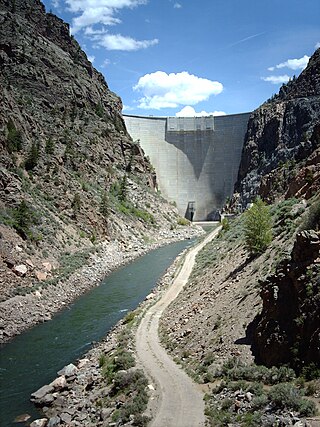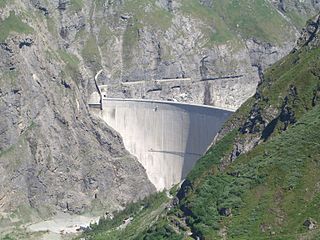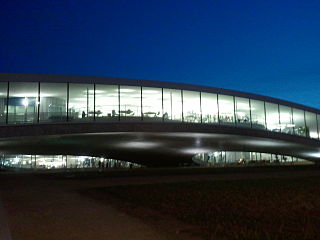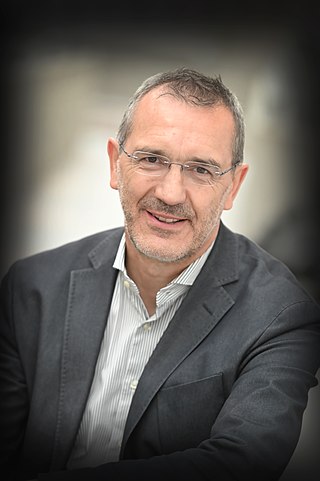
The École polytechnique fédérale de Lausanne is a public research university in Lausanne, Switzerland. Established in 1969, EPFL has placed itself as a public research university specializing in engineering and natural sciences.

An arch dam is a concrete dam that is curved upstream in plan. The arch dam is designed so that the force of the water against it, known as hydrostatic pressure, presses against the arch, causing the arch to straighten slightly and strengthening the structure as it pushes into its foundation or abutments. An arch dam is most suitable for narrow canyons or gorges with steep walls of stable rock to support the structure and stresses. Since they are thinner than any other dam type, they require much less construction material, making them economical and practical in remote areas.

The Grande Dixence Dam is a concrete gravity dam on the Dixence at the head of the Val d'Hérémence in the canton of Valais in Switzerland. At 285 m (935 ft) high, it is the tallest gravity dam in the world, seventh tallest dam overall, and the tallest dam in Europe. It is part of the Cleuson-Dixence Complex. With the primary purpose of hydroelectric power generation, the dam fuels four power stations, totaling the installed capacity to 2,069 MW, generating approximately 2,000 GWh annually, enough to power 400,000 Swiss households.

Dominique Perrault is a French architect and urban planner. He became world known for the design of the French National Library, distinguished with the Silver medal for town planning in 1992 and the Mies van der Rohe Prize in 1996. In 2010 he was awarded the gold medal by the French Academy of Architecture for all his work. He was named as the 2015 Praemium Imperiale Laureate for Architecture.

Mauvoisin Dam is a concrete variable radius arch dam across the Val de Bagnes on the Dranse de Bagnes stream, in the canton of Valais, Switzerland. Initial construction on the dam commenced in 1951 and was completed in 1957, with the reservoir filling by 1958. In 1991, the dam was raised to increase the capacity of the reservoir for winter storage. The dam's primary purpose is hydroelectric power generation.
The École d'architecture de la ville et des territoires Paris-Est, Éav&t for short, is a fully accredited state-financed architecture school located in the east of Paris, France.
Alain Wegmann was a Swiss computer scientist, professor of Systemic Modeling at the École Polytechnique Fédérale de Lausanne (EPFL), and Information Technology and Services consultant, known for the development of the Systemic Enterprise Architecture Methodology (SEAM).

The Rolex Learning Center is the campus hub and library for the École polytechnique fédérale de Lausanne (EPFL), in Lausanne, Switzerland. Designed by the winners of 2010 Pritzker Prize, Japanese-duo SANAA, it opened on 22 February 2010.
The Holcim Foundation for Sustainable Construction is a non-profit organization. Its goal is to raise awareness of the role that architecture, engineering, urban planning and construction have in achieving a sustainable built future. The organization encourages and rewards sustainable responses to the technological, environmental, socioeconomic, and cultural issues affecting building and construction. The Holcim Foundation for Sustainable Construction promotes thought leadership on a greener, smarter, circular, and more inclusive built environment.
The Balelec Festival is the largest musical event organized by students in Europe. It is usually the first open-air music festival happening in Switzerland each year during Spring. It is organised by volunteers on the campus of École Polytechnique Fédérale de Lausanne near lake Geneva in Lausanne, Switzerland around the beginning of May.
Gruner AG, with headquarters in Basel, is a Swiss engineering services company. It has 21 subsidiaries at 33 sites in Switzerland, Europe and International. The business activities include project development, general planning and consultancy tasks in building construction and infrastructure development, safety consulting, renovation, project management and controlling. The Gruner Group has over 1000 employees from over 50 different professions.

The Lausanne campus or Dorigny university campus is a large area in Switzerland where the University of Lausanne (UNIL), the École polytechnique fédérale de Lausanne (EPFL) and several other institutions are located. It is in Dorigny, towards the west of Lausanne, on the shores of Lake Geneva. The site is about 2.2 kilometres wide and 31,000 people study and work there.

The EPFL Press, formerly Presses polytechniques et universitaires romandes (PPUR) is a Swiss independent scientific publishing house and a university press affiliated with the École Polytechnique Fédérale de Lausanne (EPFL) in Lausanne, Switzerland. EPFL Press was founded in 1980 and is based on the EPFL campus, in the Rolex Learning Center.
LargeNetwork is a Swiss media agency and custom publisher.

The Émosson Dam is a hydroelectric dam development located in Switzerland in the canton of Valais.

Erna Hamburger was a Swiss engineer and professor. In 1957, she became professor of electrometry at the University of Lausanne. She was the first woman in the history of Switzerland to be named a professor at a STEM university.
cadwork informatik CI AG is a multinational software company headquartered in Basel, Switzerland. It develops and markets software products primarily for the construction industry. These products include timber industry products in computer-aided design (CAD) and computer-aided manufacturing (CAM) as well as products in building information model (BIM) and virtual design and construction (VDC). These products are suitable for designers, structural engineers, construction engineers, civil engineering draftspeople, building contractors, and in the case of BIMTeam VDC, the construction crews.

Jean-Luc Sandoz is a French-Swiss engineer and an expert in wood construction. He is the founder of several companies in the field of engineering, industrialization, construction and expertise, all related to wood. Formerly, he was a professor and lecturer at EPFL.

Arsene Tema Biwole is a cameroonian nuclear engineer and plasma physicist at the Massachusetts Institute of Technology (MIT).













